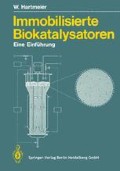Zusammenfassung
Die Affinitätschromatographie ist nicht nur als analytische Methode wichtig, sondern sie findet auch zur Gewinnung hochgereinigter Substanzen aus komplexen Stoffgemischen Anwendung. Sie nutzt die spezifische Wechselwirkung (Affinität) verschiedener biologischer Reaktionspartner, die sich in ihrem gegenseitigen Erkennen und Binden äußert. Solch eine Affinität besteht z.B. zwischen Antigenen und Antikörpern oder zwischen Hormonen und Rezeptorproteinen. Auch Enzyme haben, wie Tabelle 20 ausweist, eine Reihe von Substanzen, mit denen sie in spezifische Wechselwirkung treten.
Access this chapter
Tax calculation will be finalised at checkout
Purchases are for personal use only
Preview
Unable to display preview. Download preview PDF.
Literatur
Al-Hitt I K, Moody G J, Thomas J D R (1984) Glucose oxidase membrane systems based on poly(vinylchloride) matrices for glucose determination with an iodide ion-selective electrode. Analyst 109: 1205–1208.
Blum L J, Coulet P R, Gautheron D C (1985) Collagen strip with immobilized luciferase for ATP bioluminescent determination. Biotechnol Bioeng 27: 232–237.
Bowers L D and Carr P W (1980) Immobilized enzymes in analytical chemistry. In: Fiechter A (Hrsg) Advances in biochemical engineering, Bd 5. Springer, Berlin, S 89–129.
Clark M F, Adams A N (1977) Characteristics of the microplate method of enzyme-linked immunosorbent assay for the detection of plant viruses. J Gen Virol 34: 475–483.
Clarke D J, Blake-Coleman B C, Calder M R, Carr R J G, Moody S C (1984) Sensors for bioreactor monitoring and control — a perspective. J Biotechnol 1: 135–158.
Danielsson B (1983) Use of enzyme thermistor as a flow analyzer in biotechnology. In: Lafferty R M (Hrsg) Enzyme technology. Springer, Berlin, S 195–206.
Guilbault G G (1981) Applications of enzyme electrodes in analysis. Ann New York Acad Sci 369: 285–294.
Janson J-C (1984) Large-scale affinity purification — state of art and future prospects. Trends Biotechnol 2: 31–38.
Karube I, Matsunaga T, Suzuki S, Asano T, Itoh S (1984) Immobilized antibody-based flow type enzyme immunosensor for determination of human serum albumin. J Biotechnol 1: 279–286.
Kingdon C F M (1985) Biosensor design: microbial loading capacity of acetylcellulose membranes. Appl Microbiol Biotechnol 21: 176–179.
Makovos E B, Liu C C (1985) Measurements of lactate concentration using lactate oxidase and an electrochemical oxygen sensor. Biotechnol Bioeng 27: 167–170.
Mattiasson B, Mandenius C F, Danielsson B, Harlander P (1983) Computer control of fermentations with biosensors. Ann New York Acad Sci 413: 193–196.
Pacakova V, Stulik K, Brabcova D (1984) Use of the Clark oxygen sensor with immobilized enzymes for determinations in flow systems. Anal Chim Acta 159: 71–79.
Renneberg R, Riedel K, Scheller F (1985) Microbial sensor for aspartame. Appl Microbiol Biotechnol 21: 180–181.
Schiigerl K (1985) Sensor-Meßtechniken in der biotechnologischen Forschung und Industrie. Naturwissenschaften 72: 400–407.
Thompson R Q, Crough S R (1984) Stopped-flow kinetic determination of glucose and lactate with immobilized enzymes. Anal Chim Acta 159: 337–342.
Wieck H J, Heider G H, Yacynych A M (1984) Chemically modified reticulated vitreous carbon electrode with immobilized enzyme as a detector in flow-injection determination of glucose. Anal Chim Acta 158: 137–141.
Author information
Authors and Affiliations
Rights and permissions
Copyright information
© 1986 Springer-Verlag Berlin Heidelberg
About this chapter
Cite this chapter
Hartmeier, W. (1986). Anwendung in der Analytik. In: Immobilisierte Biokatalysatoren. Springer, Berlin, Heidelberg. https://doi.org/10.1007/978-3-662-07862-4_6
Download citation
DOI: https://doi.org/10.1007/978-3-662-07862-4_6
Publisher Name: Springer, Berlin, Heidelberg
Print ISBN: 978-3-540-16335-0
Online ISBN: 978-3-662-07862-4
eBook Packages: Springer Book Archive

